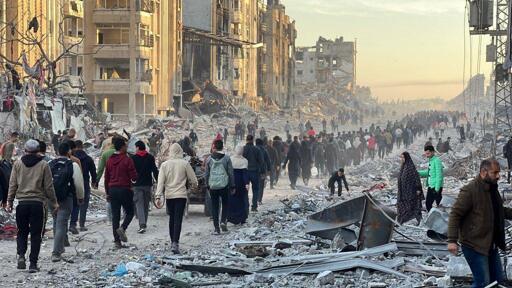Tens of thousands of Palestinians began returning to northern Gaza on foot on Friday 10 October, two years after a devastating war, following the entry into force of a ceasefire agreement between Israel and Hamas at midday, according to field reporters and eyewitnesses.
Palestinians returning to rubble in Gaza
Waves of people were seen walking along Salah al-Din and al-Rashid streets towards Gaza City, in a scene where tears mingled with hope, while the Israeli army continued its gradual withdrawal to new positions inside the Strip over the next 24 hours, in accordance with the first phase of US President Donald Trump’s plan to end the war.
Despite the joy of returning, many Palestinians were shocked by the widespread destruction they saw in the northern neighbourhoods that had been the scene of Israeli military operations. Populated areas appeared to have been completely razed to the ground, while some neighbourhoods were left with nothing but the remains of collapsed walls and bent electricity poles.
Local sources said that hundreds of returnees began searching for their relatives under the rubble or among the ruins, while civil defence teams were deployed on a limited scale due to a lack of equipment and fuel.
Early Friday morning, the Israeli government approved a ceasefire and prisoner exchange agreement with Palestinian factions, following four days of indirect negotiations in Sharm El Sheikh, with the participation of Egypt, Qatar and Turkey, and under direct US supervision.
The humanitarian crisis continues
According to the terms of the agreement, the first phase will begin with a comprehensive ceasefire, followed by a partial exchange of prisoners, with security arrangements paving the way for a gradual Israeli withdrawal from the Gaza Strip.
According to Tel Aviv’s estimates, Hamas still holds 48 Israeli prisoners, including about 20 who are alive, while more than 11,100 Palestinians languish in Israeli prisons, suffering harsh humanitarian conditions and lacking medical care, as confirmed by Palestinian and international human rights reports.
These developments come as the people of Gaza experience one of the most severe humanitarian tragedies in modern history. UN reports indicate that the Gaza Strip has become uninhabitable after two years of bombing and siege, with its infrastructure completely destroyed and most basic services shut down.
Featured image via the Canary
By Alaa Shamali
From Canary via this RSS feed


